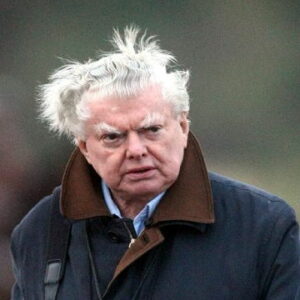Australian racehorse trainer James Bartholomew “Bart” Cummings made history by setting a record by winning the prestigious “Melbourne Cup” twelve times. He was one of the best racehorse trainers in the world and was responsible for the horses who finished first and second in the ‘Melbourne Cup races in 1965, 1966, 1974, 1975, and 1991. By winning more than a thousand races, he rose to fame in the Australian and international horse racing industries. They included 266 victories in Group 1 races, and more than 763 victories in stakes, including victories in the Melbourne Cup (12 times), Cox Plate (5 times), Golden Slipper Stakes (4 times), Newmarket Handicap (8 times), and VRC Oaks (9 times). As long as he was alive, he was regarded as an “Australian National Living Treasure.” Due to his numerous victories in horse races, he was given the moniker “Cups King.” He has an extraordinary understanding of horses and was able to read their capacities by running his fingers over their bodies. He appeared to be communicating with the horses through his hands, much like a horse whisperer. He made history by becoming the first horse trainer to have produced winners who took home more than $1 million in prizes.
Early Childhood & Life
J.B. Cummings, also known as Bart Cummings, was born in Adelaide, in southern Australia, on November 14, 1927. His father, Jim Cummings, was a well-known Irish horse trainer who had trained “Comic Court,” the horse that had won the 1950 Melbourne Cup. Annie Whelton Cummings was his mom.
Pat was his older brother, while Teresa was his sister. He attended the Senior School of the “Marist Brothers Sacred Heart College,” which is located in the Adelaide suburb of Somerton Park, for his first year of school but dropped out at the age of 14.
Bart Cumming’s Career
Beginning in 1950 as a strapper for his father’s “Melbourne Cup” champion horse “Comic Court,” Bart Cummings learned all the nuances of horse racing from him. He established his own stable at Glenelg in Southern Australia after receiving his trainer’s license in 1953. He acquired his first yearling in 1958, and that same year, he won the South Australian Derby. His horse “Asian Court” finished in 12th place in the 1958 “Melbourne Cup” competition. His subsequent entry, “Trellios,” came in fifth place in the 1959 “Melbourne Cup.”
His runner, “Sometimes,” barely managed to finish in sixth place in 1960. In 1965, he entered three horses in the event; Light Fingers, the first horse, won, Ziema, the second, finished second, and The Dip, the third horse, finished eighth. He won the cups at the Caulfield, Sydney, Adelaide, Brisbane, Sandown, and Queen’s races in the 1965–1966 season, coupled with his first “Trainer’s Premiership.” In 1968, he built a brand-new stable called Saintly Lodge close to the Flemington Racecourse in Melbourne.
He won the “Trainer’s Premiership” races in South Australia and Victoria the same year. In 1969 and 1970, he repeated the feat. Despite being the favorite, Big Philou, his horse who had previously won the Caulfield Cup, was unable to compete in the Melbourne Cup because it had been illegally given a laxative. He made history in 1974 when he became the first coach to earn $1,000,000 in prize money in a single season.
In 1975, he relocated to a brand-new stable called “Leilani Lodge” close to Sydney’s “Randwick Racecourse.”
He spent millions of dollars on numerous horses in the late 1980s. Although the early 1990s recession severely damaged him, he continued his racehorse training programs with the support of the “Reg Inglis” organization, which prevented him from going bankrupt.
He won the ‘Trainer’s Premiership for Melbourne, Adelaide, and Sydney in 1990, which was unique. He was the first licensed individual to be granted a lifetime membership in the “Victoria Racing Cup” in 2004.
In 2008, his horse “Viewed,” won the event in a photo finish, earning him his twelfth “Melbourne Cup” victory. He commemorated the occasion by entering a runner for the race for the 50th time.
Bart’s Bigger Works
Based on his 60 years of expertise with racehorses, Bart Cummings wrote a book titled “Bart: My Life.”
Recognition & Achievements
In 1982, Bart Cummings received recognition for his contributions to the horse racing business when he was named a “Member of the Order of Australia.” On December 11, 1991, he was admitted into the “Sport Australia Hall of Fame.” He was added to the list of “National Trusts Australian Living Legends” in 1997. In 2000, he received a “Centennial Medal” and had the privilege of carrying the Olympic Torch. In 2001, he was also admitted to the “Australian Racing Hall of Fame.”
The Australian Postal Service published a postage stamp with his likeness as part of a series called “Australian Legends” to honor him. In May 2008, the racing organization “Racing NSW” established a medal called “The Bart Cummings Medal” that would be given to a jockey or trainer who had demonstrated excellence and consistency.
Personal Legacy & Life
He had been married to Valmae for 61 years beginning in 1954. Anthony was the only son born to the couple; the other children were daughters Anne-Marie, Margaret, and Shanon. Two days after celebrating his 61st wedding anniversary with his wife, Bart Cummings passed away in his sleep on August 30, 2015, at Prince’s Farm in Castlereagh, New South Wales.
Estimated Net Worth
The estimated net worth of Bart Cummings is $6 million, and his main source of income is as a horse trainer. We don’t have adequate proof of Bart Cummings’ lifestyle or his vehicles.
Trivia
Bart Cumming was allergic to hay and horses and had asthma since he was a very young child. Yet he excelled and became one of the greatest racehorse trainers ever.


